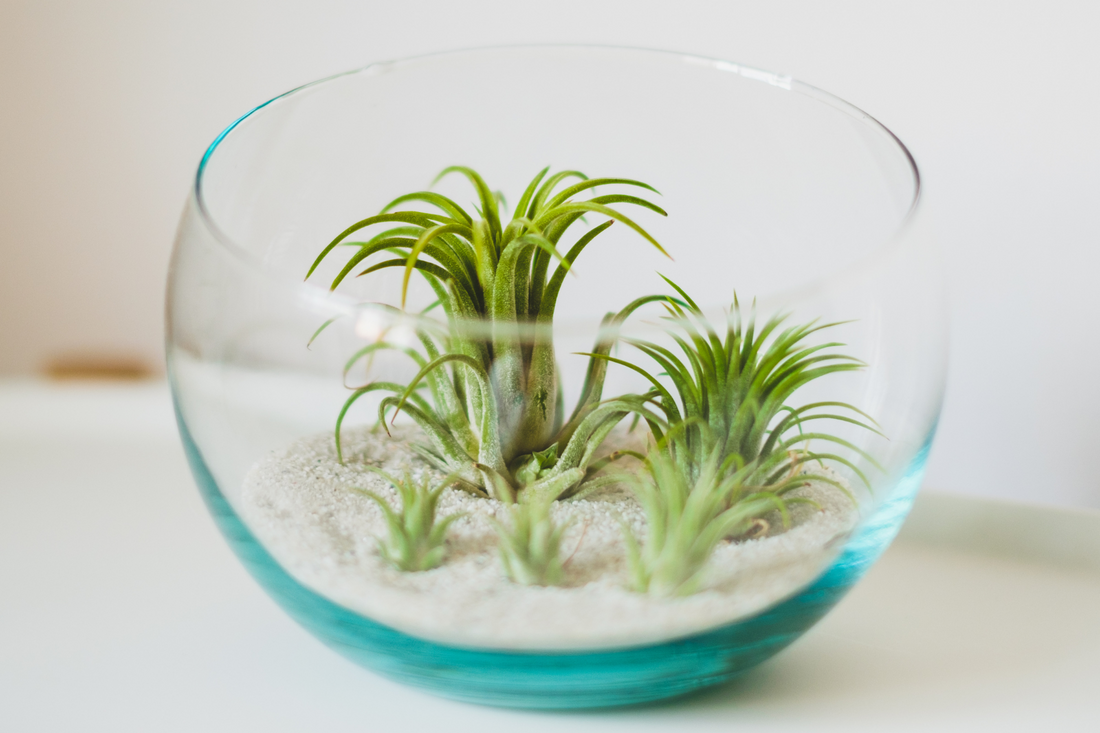Tillandsias (air plants) are such beautiful and unique plants that belong to the bromeliad family. Today, they are a very popular house plant for many reasons. What plant lovers find most interesting about them is that they epiphytic (grow on trees) so they do not require soil to live. They instead absorb all their nutrients from the air, as their name suggests, thus making them super fun to display! But that isn’t the only interesting thing about air plants – did you know they are also monocarpic? That means that each plant only flowers once in their lifetime before dying. In this article, we will explain to the unique and poetic life cycle of the Tillandsia air plant.
Seedling: Like all other living things, there is a beginning of life. Air plants can either be grown by seeds produced post pollination, or by the plant producing offsets or “pups”. Commercially, the second method is typically used as air plants grown from seed can take a while. When the pups reach a stage where they will no longer rely on the mother plant the survive, they are separated and are usually sold as single plants.
Mature: As air plants age and mature, they grow larger and settle more into their true form. The age of maturity and rate of growth depends on the species of air plant. Some species mature very quickly while others take many years. They can be fertilized during growing seasons to help them grow bugger. As air plants mature, the tend to grow roots systems from the base of the plant. Due to their nature, primarily air plants grow roots to help them attach to their host. Mounting them is a great idea but if a unique display or terrarium is preferred, the roots can be trimmed causing no harm to the plant itself. Some species grow in clusters making for a pretty attractive display while some other larger species such as the Tillandsia Cyanea, which grow short and fragile root systems, are typically grown in an epiphytic substrate (consisting of peat moss, perlite, and fir bark) to help give the plant stability as it grows larger.
Flowering: One of the most exciting experiences of air plant parenthood is witnessing an air plant flower. This is a bittersweet stage in an air plants life as this is essentially the beginning of the end of an air plants life cycle. The flowering stage itself, from budding to full bloom, can take anywhere from a couple weeks to a several months depending on the species. Air plants that form large and complex flowering bracts, such as T. Xerographica, and T. Fasciculata, can take months before reaching full bloom. Whereas as air plants such as T. Ionantha, and T. Funckiana, species that don’t grow these bracts, can flower within a week or two from when you first notice the buds appearing.
Tillandsia Ionantha and Tillandsia Funckiana
Tillandsia Bulbosa, Tillandsia Fasciculata, and Tillandsia Houston
Air plant flowers (inflorescence) range in a variety of vibrant colours such as hot pink, orange, fiery red, purple, yellow, and even white! The colour of the flowers depend on the species. Bright sunlight and more frequent watering can aide in progressing the blooms along, however, it is recommended to avoid soaking the flower bract for too long as it may rot.
Offsetting: Shortly after flowering, the air plant will stop growing and will begin to fade. Don’t worry, this won’t happen overnight. The life span of air plants after flowering will be unique to each plant – it can take several weeks or months. During this time, the mother plant will produce offsets or pups and the number of pups will vary depending on species. Fun fact: certain species offset profusely and can produce pups even before flowering!
"The End": Now the mother plant has given the remainder of its energy to the pups and will die off. But in the mother plants’ final days it has given the pups a magnificent head start ensuring the circle of life continues. An awfully beautiful end of life if you ask us! At the stage, the pup(s) can be separated by the mother plant using a sterile knife however many air plant enthusiasts like to keep the pups attached to encourage cluster growth.
The one question we are asked most frequently is “when will my air plant flower?” and the answer is: it depends. It depends on the species, how mature the plant is, your home environment, how it is cared for, etc. Ultimately, there is no need to rush the process. It will happen naturally as it is intended. Just enjoy and cherish your magical air plants and give them the best life that you can. One day the plant will reward you, and trust us, it’s worth the wait!

